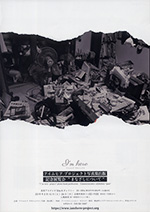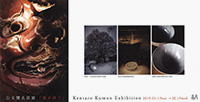 |
Picks is a monthly sampling of Japan's art scene, offering commentary by a variety of reviewers about exhibitions at museums and galleries in recent weeks, with an emphasis on contemporary art by young artists. |
 |
 |
|
|
 |
 |
 |
 |
| Kiyoshi Niiyama: Vintage |
| 13 February - 27 April 2019 |
Gallery Bauhaus
(Tokyo) |
 |
| Though ostensibly an amateur photographer, Niiyama (1911-1969) was constantly active with his camera, showing his work in numerous photography magazines and exhibitions and winning many prizes before his life was tragically cut short. This show features 49 vintage prints (the first made by the photographer immediately after developing the negative) from the 1940s through the 1960s. Amateur photography in Japan began to go into creative decline in the 1970s, so Niiyama's work represents one of the last flashes of the genre's brilliance. |
|
|
 |
 |
|
| Tsuneo Enari: After the Tsunami |
| 28 February - 6 March 2019 |
Zen Foto Gallery
(Tokyo) |
 |
| Enari (b. 1936) began photographing the tsunami-devastated coasts of Iwate, Miyagi and Fukushima prefectures in May 2011, barely three months after the Tohoku Earthquake. This exhibition, a repeat of one he held last year at Sagamihara Citizen's Gallery, introduced 56 works selected from his output during the seven years between 2011 and 2018. Enari is a by-the-book documentarian, and the large monochrome prints that lined the walls scrutinized their subjects in gimlet-eyed detail, filling the gallery with a palpable tension. |
|
|

|
 |
 |
|
 |
 |
 |
| I'm Here Project |
| 16 - 24 February 2019 |
Site-A Gallery Beneath the Railways
(Kanagawa) |
 |
| After living as a recluse for three years, contemporary artist Atsushi Watanabe began producing work related to that experience, leading to his "I'm Here Project," which assembles work by others with similar backgrounds. Installations that involve breaking through the door of a room or tearing painful-looking gashes in the walls seem to express the cruelty of gratuitous attempts to expose the recluse's lifestyle to the light of day, or the violence of meddlers who try to draw recluses out to become "productive" members of society. |
|
|
|
|
|
|
|

|
 |
 |
 |
 |
| Kentaro Kumon Exhibition |
| 15 January - 13 February 2019 |
Emon Photo Gallery
(Tokyo) |
 |
| New photography by Kumon, whose previous exhibition featured powerful images on the theme of farming in Japan. This time he expanded his perspective to encompass the life, work, and culture of people rooted in their land. The show was divided into three "chapters" on varying themes that together painted a comprehensive picture of the substrata underlying contemporary Japanese society and culture. The well-crafted installation, which included hanging photographs from the ceiling, was also indicative of Kumon's fertile imagination. |
|
|
 |
 |
| Fumikiyo Nagamachi: Old Village |
| 1 - 17 February 2018 |
Photographers' Gallery
(Tokyo) |
 |
| Nagamichi's M.O. for the works shown here was to aim his camera at scenes he happened upon while strolling around his neighborhood. The result is a series of unpretentious, even prosaic images, all shot in the city of Machida, where Nagamichi lives. Machida is a rather peculiar place -- though technically part of Tokyo, it has the air of a provincial town. This is the atmosphere that Nagamichi successfully captures in his photographs. |
|

|
 |
 |
 |
 |
|
| Harumichi Saito: Kando |
| 19 January - 30 March 2019 |
Tokyo Metropolitan Human Rights Plaza
(Tokyo) |
 |
| Photographer Saito (b. 1983), himself hearing-impaired, shoots positive, light-filled portraits of others who share the experience of being a social minority in various ways. These works give eloquent form to kando, the experience of profound emotion (Saito describes it as a sensation that "makes one speechless, makes one sob, inspires one's very existence") that is also the title of his 2011 photo collection, which this show revisited. |
|
|
 |
 |
 |
| Arthur Miller: The Crucible |
| 8 - 13 February 2019 |
New National Theatre Tokyo
(Tokyo) |
 |
| Based on the Salem Witch Trials, which took place in colonial Massachusetts in the late 1600s, this play was written by Miller in the early 1950s at the height of the anti-communist hysteria of McCarthyism. Clocking in at over three hours, the performance gets off to a slow start with leisurely plot development that this viewer found less than engaging. After intermission, though, the narrative erupts in intensity as it fiercely confronts the nature of fanaticism, and indeed of humanity itself. |
|
|
|
|
|
|
|
|
|
 |
|